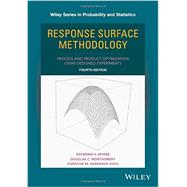Praise for the Third Edition:
“This new third edition has been substantially rewritten and updated with new topics and material, new examples and exercises, and to more fully illustrate modern applications of RSM.”
- Zentralblatt Math
Featuring a substantial revision, the Fourth Edition of Response Surface Methodology: Process and Product Optimization Using Designed Experiments presents updated coverage on the underlying theory and applications of response surface methodology (RSM). Providing the assumptions and conditions necessary to successfully apply RSM in modern applications, the new edition covers classical and modern response surface designs in order to present a clear connection between the designs and analyses in RSM.
With multiple revised sections with new topics and expanded coverage, Response Surface Methodology: Process and Product Optimization Using Designed Experiments, Fourth Edition includes:
- Many updates on topics such as optimal designs, optimization techniques, robust parameter design, methods for design evaluation, computer-generated designs, multiple response optimization, and non-normal responses
- Additional coverage on topics such as experiments with computer models, definitive screening designs, and data measured with error
- Expanded integration of examples and experiments, which present up-to-date software applications, such as JMP®, SAS, and Design-Expert®, throughout
- An extensive references section to help readers stay up-to-date with leading research in the field of RSM
An ideal textbook for upper-undergraduate and graduate-level courses in statistics, engineering, and chemical/physical sciences, Response Surface Methodology: Process and Product Optimization Using Designed Experiments, Fourth Edition is also a useful reference for applied statisticians and engineers in disciplines such as quality, process, and chemistry.








